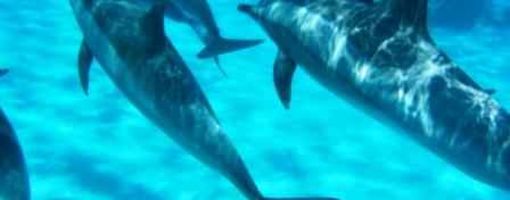Dolphins

Dolphin, aquatic mammals of the suborder Odontoceti, closely porpoises.
Dolphins, like all cetaceans, breathing air, surfacing periodically to the surface to make a modified single breath through the nostril - blowhole, located on the head. Feed mainly on fish and squid, although some species prefer shrimp and other crustaceans, and orcas eat as sea turtles, aquatic mammals and birds. The majority of dolphins are larger than females and males of some species differ from them in the higher dorsal fin. After a gestation period, component, depending on the species, from 12 to 16 months, only one calf is born. The mother nurses him under the water with milk at least six months and sometimes up to two years, starting to wean from the nipple through 6-18 months. Known individuals under the age of 50 years, although most species maximum life span of 20-25 years.
Species of the family Delphinidae live in all seas and sometimes entering the mouths of large rivers. Representatives of families of freshwater or river, dolphins (Platanistidae) have a much more limited distribution. They mostly inhabit the inland fresh water, although some of them can penetrate into brackish estuaries and even in coastal areas of seas. Stenidae family includes species that inhabit the seas, fresh waters or in both these environments.
Externally Delphinidae are distinguished primarily by acting beak, which is clearly distinguished from the forehead. The exceptions are few species with convex spherical forehead. Depending on the species of Delphinidae from 2 to 250 conical teeth. Dorsal fin, if present, is usually more crescentic than triangular, and if it is not bent, it is very high, as in the male killer whale. Freshwater dolphins are different in that they have cervical vertebrae are separated, as in terrestrial mammals, but not merged into a single bone. In some species of this family except for conical teeth are molyarovidnye, ie, similar in structure to the indigenous. The dorsal fin is usually very low, as a crest; only laplatskogo dolphin it is the same as that of Delphinidae.
Most Delphinidae live in packs and can, for example, dolphin, to form a huge cluster. However, they are usually small groups: from 2-3 to approximately 100 individuals. At least some species seem to be characteristic of a clear social organization.
Delphinidae are usually very active and often extremely fast swimmers, periodically jumping out of water. Some species, such as dlinnoryly prodelfin even perform intricate shapes in the air, while others love to wallow, diverging from the nose of a moving ship.
Most Delphinidae property is widely published repertoire of sounds. Firstly, it is the pulse signals of the two main types: sonar and expressing emotional state. Secondly, dolphins emit sounds monotonalnye resembling a whistle. In individuals of some species, its frequency is individual and is used to recognize each other member of the pack. In addition, the volume and frequency of whistles reflect the emotional state of a dolphin. Some specimens are marked helper monotonalnye signals - as stereotypical and characteristic for each of them.
Twitter pulses, divided into many different types, which are usually characteristic for the species rather than individuals. Attempts to find a connection between Twitter and the behavior of the dolphins, but all the twitter for the most part similar to each other and gradually merge into each other. Although such signals reflect a particular emotional state, it is understandable to other dolphins than people-observers, and there is no evidence that these sounds actually form a language in human understanding. The same can be said for monotonalnyh whistles.
Your Rating:
Overall rating: 0.000
Totally voted: 0
Comments
Weather in:
Exchange Rates
-
IMF loan expected next month
Apr 22, 2013, rating: 3.000, 3 votes Egypt may secure an International Monetary Fund loan agreement in about amonth, state news agency MENA reported, quoting "informed" sources ...
Egypt may secure an International Monetary Fund loan agreement in about amonth, state news agency MENA reported, quoting "informed" sources ...
-
Egypt received 11 million tourists in 2012 and aims to boost that number to 14 million in 2013.
Jan 22, 2013, rating: 3.000, 2 votes
Egypt received 11 million tourists in 2012 and aims to boost that number to 14 million in 2013.
-
Egypt limits travelers leaving country to US$10,000 in cash
Dec 26, 2012, rating: 3.250, 4 votes Egypt has banned travelers from carrying more than US$10,000 in foreigncurrency cash in or out of the country ...
Egypt has banned travelers from carrying more than US$10,000 in foreigncurrency cash in or out of the country ...
-
National Coalition on Climate Change for Egypt is born
Nov 30, 2012, rating: 5.000, 1 votes The global COP18 conference on climate change opens in Doha Monday.About 17,000 participants from all over the world ...
The global COP18 conference on climate change opens in Doha Monday.About 17,000 participants from all over the world ...
-
Egyptian family's average annual income is LE25,000, agency reports.
Nov 29, 2012, rating: 5.000, 1 votes The average annual Egyptian household income during 2010-2011 wasLE25,353, according to the Central Agency for Public Mobilization andStatistics.
The average annual Egyptian household income during 2010-2011 wasLE25,353, according to the Central Agency for Public Mobilization andStatistics.
-
Judgment for sexual harassment
Nov 14, 2012, rating: 3.600, 5 votes A man was sentenced to two years in prison and fined LE 2,000 for sexually harassing a woman, an ...
A man was sentenced to two years in prison and fined LE 2,000 for sexually harassing a woman, an ...








